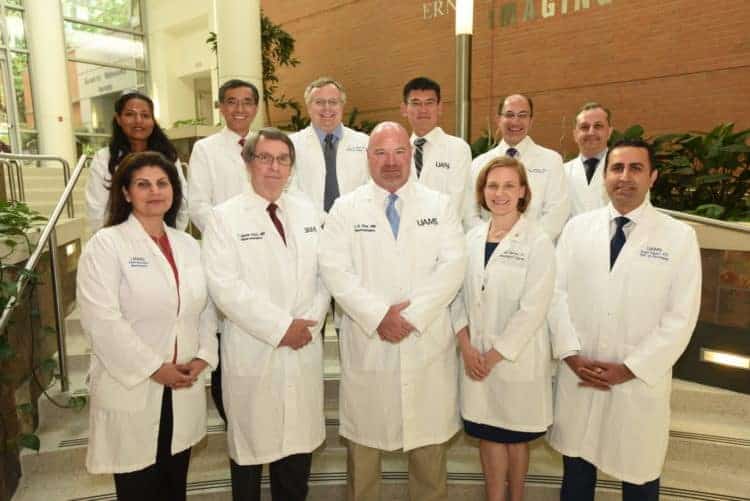Neurosurgery Department’s Gender, Racial Diversity Bucks National Trends
| July 17, 2018 | Looking around the Department of Neurosurgery at UAMS, you would be forgiven for not knowing that brain surgery is a profession with a reputation for a lack of diversity.
That is because the makeup of the department doesn’t reflect national trends. Three of its 10 faculty are female. Of its 11 residents, two are African-American men. The department welcomed its sixth female resident in July.
In contrast, women made up 7.8 percent of practicing neurosurgeons in 2015, the latest figures available from the Association of American Medical Colleges (AAMC). The number of female residents in neurosurgery was 17.1 percent in 2015, compared to 10.4 percent in 2005.
African-Americans in neurosurgery are even less well represented. AAMC figures from 2008 put the number of African-American neurosurgeons at 4 percent of the total number of active neurosurgeons in the United States. Only 25 of them were African-American women, or 0.7 percent of the total.
“My main goal is merit,” said J.D. Day, M.D., professor and chairman of the Department of Neurosurgery. “I want people who are here because they’ve worked hard and done their best. I believe the diversity in our program is reflective of our cultures and values. It shows that we have attracted and selected the right group of people.”
Erika Petersen, M.D., is the residency program director and director of the Section of Functional and Restorative Neurosurgery in the Department of Neurosurgery. As a female in neurosurgery, she likes to give back by participating in programs for young people. She is sometimes asked why the department is so diverse and why that diversity is beneficial.
“I think we’ve created a culture where people feel welcome. No one is here because they fit a category. They’re here because we responded to them and they responded to something about what we do,” Petersen said.
She believes the diversity of the faculty allows potential residents to see themselves fitting in.
“I think our program is excellent. I think we’re doing a good job of training neurosurgeons, and we have practices here that are national and internationally known, and those are the reasons a candidate should want to be here,” Petersen said. “But if there are candidates giving us a second look because they think they would be more comfortable training here because they can see themselves in one of our faculty or they like the team or our family feel – then hey, that’s great too. At the end of the day, our goal is attracting the best people with the best fit.”
Petersen believes diversity is good for mentorship, patients and team-building among the residents. The residents, medical students and even younger students who interact with UAMS faculty and might be inspired to go into medicine benefit from having a variety of mentors to look up to. Patients benefit from having greater options in finding a doctor-patient relationship that works for them.
Heather Pinckard-Dover, M.D., is among the current group of neurosurgery residents. She is on schedule to finish in June 2020. When she does so, she will be the first female to complete her neurosurgery residency at UAMS.
Pinckard-Dover, who also obtained her medical degree at UAMS, decided in high school that she wanted to pursue neurosurgery after seeing a video of a deep brain stimulation surgery and the massive difference it made for the patient, who had Parkinson’s disease. She grew up in Pine Bluff and never bought into the idea that there were some things girls couldn’t do. So it didn’t bother her all that much when all of the early neurosurgery mentors she met during her undergraduate studies at Baylor University were male or that she was the only female trainee during the first year of her residency.
Still, Pinckard-Dover said it was nice to start working with Petersen early in medical school and that there was female representation available on the faculty when she began the hard work of seguing into her residency. It made the transition smoother, she said. Pickard-Dover agreed with Petersen that the diversity of the current group of residents has been its own kind of education. She believes it makes her a better physician.
“Working with a diverse group adds a whole new level to our education. When you have people of differing backgrounds and with differing perspectives, I think it makes you more empathetic,” Pinckard-Dover said.
